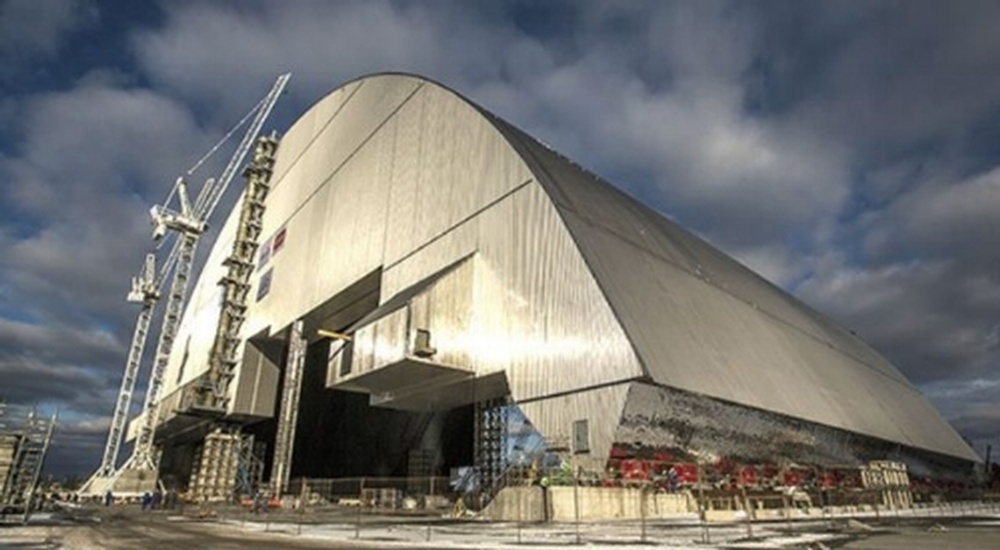
Chernobyl Radiator Covered by Kalzip
- Exterior Technologies Group
The Chernobyl damaged reactor is now safely confined thanks to the word and dedication of the 10,000 employees of NOVARKA (50% VINCI Construction Grands Projets, leader, and 50% Bouygues Travaux Publics) since the contract was signed in 2007. This project, stemming from the international ideas contest launched by Ukraine in 1992 and won by Campenon Bernard SGE (which later became VINCI Construction Grands Projets), allows both confinement and dismantling of the damaged reactor thanks to remote controlled tools installed inside the arch. The New safe Confinement was built in front of the reactor, in a cleaned area, and then slid over 327 meters since the beginning of November 2016. Chernobyl’s giant New Safe Confinement (NSC) completely encloses a previous makeshift shelter that was hastily assembled immediately after the 1986 accident.
A ceremony in Chernobyl marked the successful conclusion of the sliding operation, a key milestone before the finalisation of the international programme to transform Chernobyl into an environmentally safe and secure state by November 2017. Thirty years after the nuclear disaster in Chernobyl, the radioactive remains of the power plant’s destroyed reactor 4 have been safely enclosed following one of the world’s most ambitious engineering projects.
German company delivers stainless steel envelope
What happened on the 26th of April 1986? Anyone old enough will immediately think of the day when the reactor exploded in Chernobyl, Ukraine, spreading radioactive fallout across the entire northern hemisphere. The nuclear catastrophe contaminated a huge area of Ukraine around the nuclear power station with radiation, making it uninhabitable. Chernobyl was the first event ever to be classified as a “catastrophic accident” on the seven-level international evaluation scale for nuclear and radiological events. The 26th of April 2015 was the 29th anniversary of the disaster.
The project of the century
Five years ago, on the 26th of April 2012, construction began on a new protective cover. The new high-tech jacket consists of an inner and outer layer and is designed to last for one hundred years. The 29,000-tonne steel shelter extends in an arc over the destroyed reactor block and the old concrete sarcophagus. At 257 metres wide, 150 metres long and 109 metres high, it is the world’s largest movable hall. This was followed by hermetic sealing and the commissioning of the large pumps, which generate constant overpressure between the inner and outer layers. This overpressure is intended to prevent contaminated particles from escaping into the construction and the surroundings. Only then can the demolition work be expected to begin.




Building envelope comes from Koblenz
Kalzip is the only German company directly involved in the Chernobyl project. The Koblenz-based international manufacturer of metal building envelope was chosen to build the 86,000m2 metal inner and outer skin from stainless steel. The proven Kalzip standing seam roof cladding is being used for the outer skin. For the inner skin, a panel system also made from stainless steel is used. The profiles and panels are manufactured and processed directly on site, in mobile production units.
The complexity of the project has led to repeated delays in recent years. The planned completion date was pushed back from late 2015 to 2017. The projected costs were last recorded at more than EUR $1.5 billion and are expected to have climbed higher. The threat of a halt in production in late 2014 was averted thanks to intermediate financing from the European Bank for Reconstruction and Development (EBRD). The project was funded by various donor countries, with the majority of the Chernobyl Shelter Fund (CSF) being borne by the G7 states and the EU.

Chernobyl NSC beginning movement
Key Specs
- Arch span: 257 meters
- Arch height: 108 meters
- Covered length of the arch: 162 meters (nearly two football fields)
- Metal frame: 25,000 metric tons (nearly 3 times the weight of the Eiffel Tower)
- Total weight of the equipped structure: 31,000 mt
- Life span of the confinement shelter: 100 years
- Exterior cladding: 86,000 sq meters
- Overhead bridge cranes: 2 x 750 mt
- Overhead bridge crane girders: 100 meters (equivalent to a football field)
- Loads supported by the overhead bridge cranes: 50 mt vertical
- Final foundations: 20,000 cubic meters of concrete
- Engineering: 2.2 million hours
- Construction: 9 million hours
About Kalzip
Kalzip, the world’s leading aluminium standing seam system for roof and building cladding, was launched on the market in 1968. Since then, more than 100 million square metres of Kalzip profile panels have been laid worldwide. Kalzip is an independent business unit within Tata Steel Europe and is part of the Building Envelope sector. The construction systems produced are marketed under the worldwide registered trademark Kalzip. With production fleet of mobile production units as well as more than 25 sales/consulting and representative offices, Kalzip is represented in every part of the world. Tata Steel Europe is Europe’s second largest steel manufacturer and a company within the worldwide Tata Group.
Interested in Kalzip? Contact us
